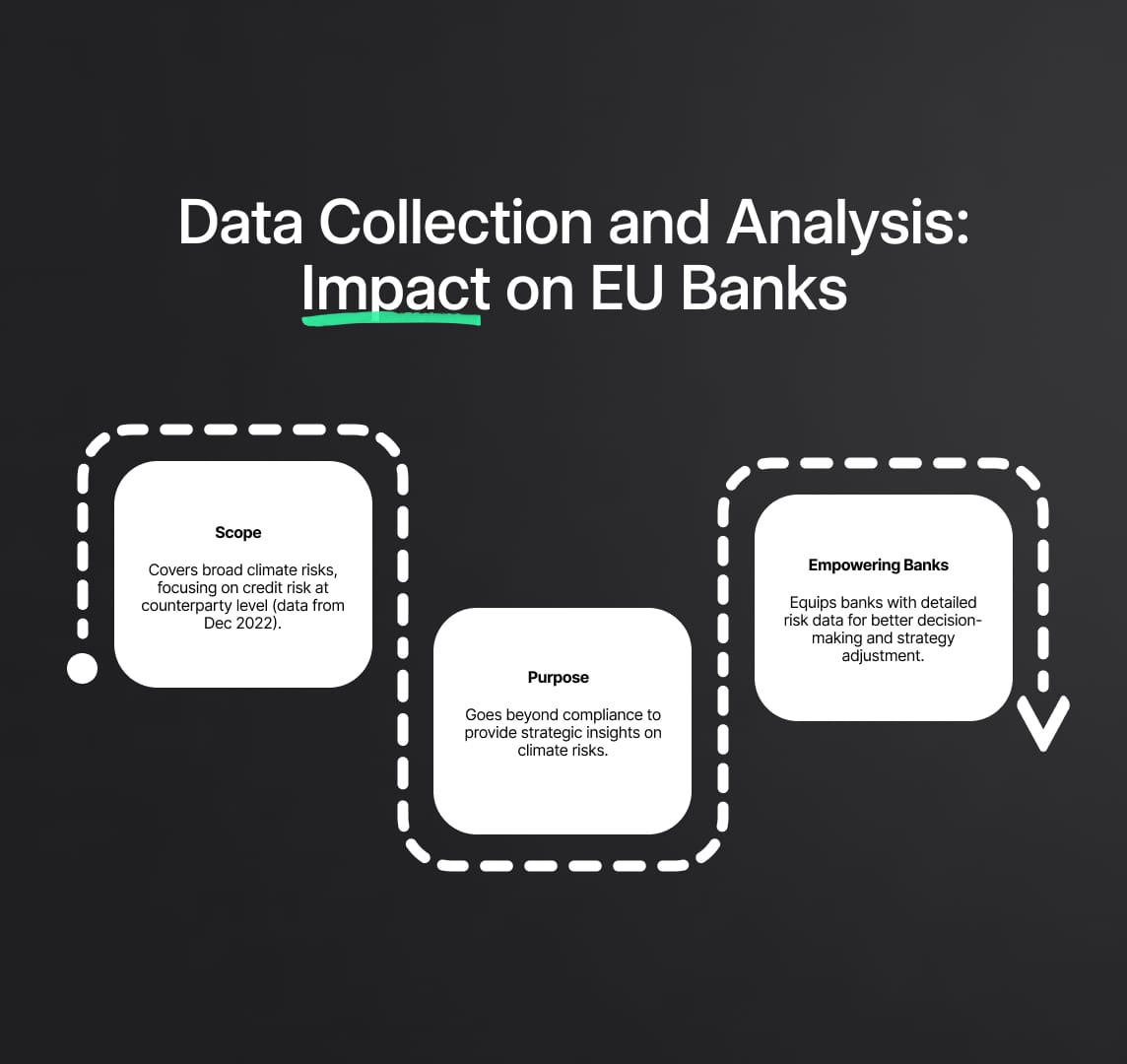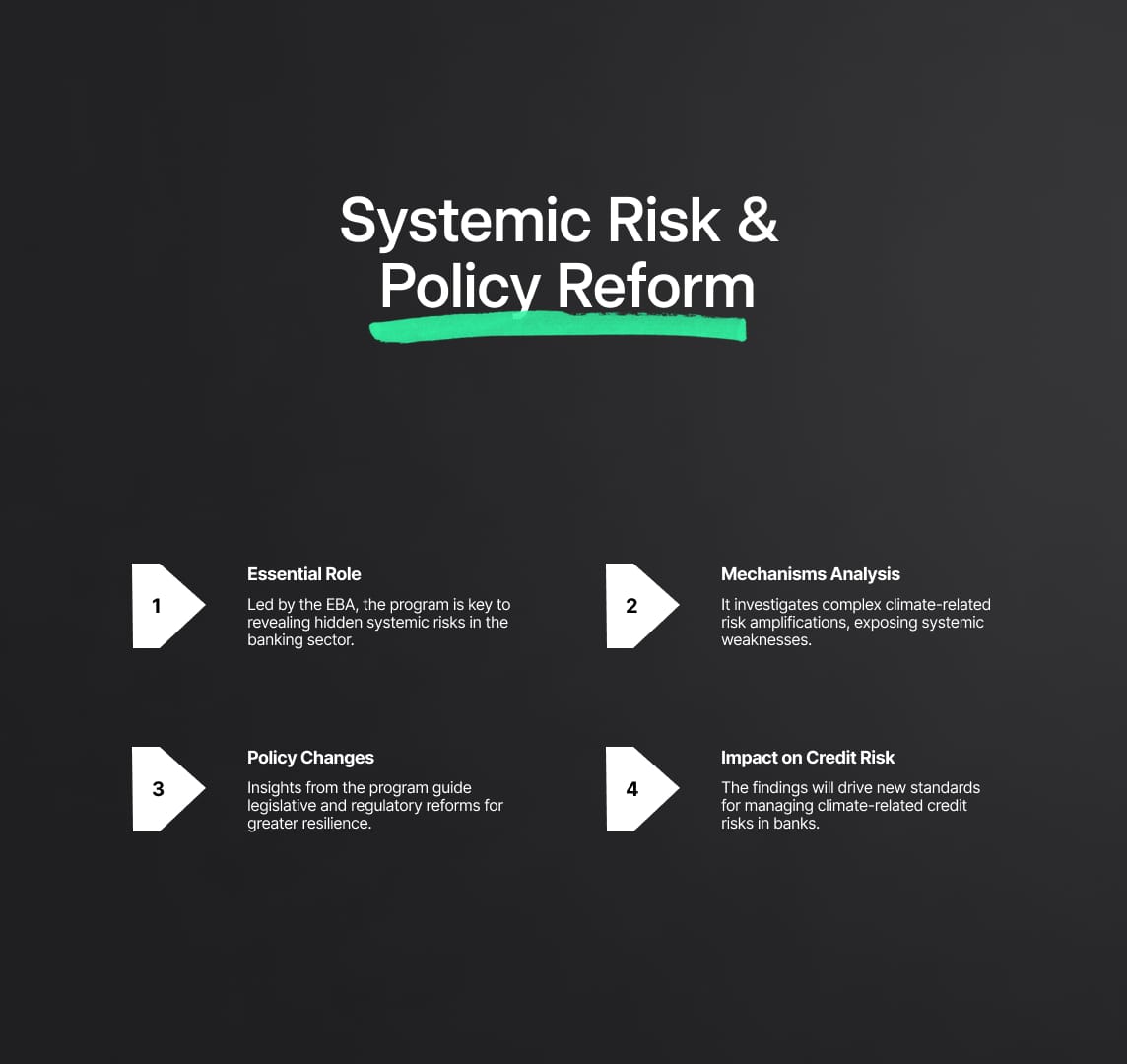EU Banks: Credit Risk Data Collection
The EBA's initiative for EU banks targets climate-related financial risks, focusing on credit risk. Scheduled for Dec 2023 to Mar 2024, it involves comprehensive data collection from 110 banks.

EBA Climate-Related Credit Risk Data Collection from EU Banks
The European Banking Authority (EBA) has taken a significant step in mitigating climate-related financial risks by introducing comprehensive templates that are intended to collect necessary data from EU banks. The ground-breaking Fitfor55 climate risk scenario analysis relies heavily on these templates. Their main goal is to gather as much information as possible from a large number of 110 EU banks, with a focus on credit risk as well as market and real estate issues. The precisely scheduled start date of this massive data collection project is December 1, 2023, with a completion date of March 12, 2024.
This experiment goes farther than just compiling data; it explores the details of counterparty level data as of December 2022. The EBA has taken a deliberate approach in examining the concentration risk associated with significant climate exposures in detail. In addition, it seeks to identify and comprehend the intricate systems that might intensify side effects and provide new hazards.
This EBA project is a proactive move to strengthen the EU financial sector's resilience against climate-related risks, not only a compliance exercise with regulations. The EBA recognizes that climate change can have a substantial influence on borrowers' ability to repay loans, which in turn impacts bank stability, and is focusing on credit risk. This method is essential for locating weak points in the banking system and creating plans to reduce the risks associated with them.
Additionally, by gathering this data, banks will be able to gain important insights into the ways in which various industries and regions are affected by climate change, which will help them decide how best to price risk and allocate resources. It also fits in with the larger EU objectives of moving toward a more sustainable economy, since banks are essential to funding this shift.
All things considered, the EBA's effort is a big step toward incorporating climate-related risks into EU banks' financial risk management systems. It emphasizes how crucial it is to comprehend and manage credit risk in light of environmental shifts and backs the EU's pledge to have a sustainable financial future. This endeavor not only supports worldwide efforts to mitigate climate change and its financial ramifications, but it also adds to the stability and strength of the banking industry.
Credit Risk in EU Banks: The EBA's Climate Data Initiative
The European Banking Authority (EBA) has taken on a vital task: incorporating financial risks related to climate change into EU banks' risk management systems. This work, which is essential to the Fitfor55 climate risk scenario analysis, entails the use of creative templates for data collection. These templates are intended to collect a broad range of data, with a particular emphasis on important domains like real estate risk, credit risk, and market risk. Understanding that climate change poses serious threats to bank financial stability and necessitates a comprehensive approach to risk assessment and management is reflected in the EBA's policy. In order to protect the larger financial system, this project is a proactive step toward making sure EU banks are ready for and resilient against the financial effects of climate change.

Data Collection and Analysis: Impact on EU Banks
With effect from December 1, 2023, to March 12, 2024, the European Banking Authority (EBA) has launched a focused data gathering campaign that includes a significant sample of 110 EU banks.
- Scope and Focus:
- Encompassing a comprehensive array of climate-related risks, the initiative places significant emphasis on unraveling credit risk.
- The data collection process meticulously captures details at the counterparty level, referencing information as of December 2022.
- Strategic Intent:
- Beyond a regulatory mandate, this extensive data collection serves as a strategic tool.
- It offers a profound understanding of how climate-related risks are currently unfolding in the financial landscape.
- Empowering Banks:
- Providing banks with in-depth insights, the initiative becomes a linchpin for informed decision-making.
- Armed with a nuanced comprehension of climate-related risks, banks can adapt their strategies to navigate the evolving risk landscape effectively.
The EBA's coordinated effort goes beyond simple regulatory observance. It turns out to be a crucial tactic, giving banks the know-how needed to handle the complexities of climate-related risks and guaranteeing the financial sector's resilience in the face of these changing difficulties.
Proactive Management of Credit Risk in the Context of Climate Change
The proactive management of credit risk in light of climate change is a key component of the EBA's effort. This strategy is essential for EU banks since it helps them recognize any weaknesses related to external circumstances and get ready for financial shocks. Banks must comprehend both the direct and indirect effects of climate change on credit risk in order to preserve their financial stability. It entails creating reliable risk assessment models that account for climate-related variables and putting effective risk-mitigation methods into action. It is imperative to take a proactive approach to credit risk management in order to ensure long-term sustainability and resilience against climate change, in addition to meeting legal requirements.

Uncovering Systemic Risks and Steering Policy Changes
- Essential Role:
- The data collecting program, which is being positioned as a major exercise, is being directed by the European Banking Authority (EBA) and is a vital tool for uncovering hidden systemic risks in the banking industry.
- Amplification Mechanisms Analysis:
- The program explores the amplification mechanisms and second-round consequences brought on by climate-related concerns, going beyond superficial examination.
- This level of analytical detail offers insightful information on the systemic weaknesses present in the banking industry.
- Informing Policy Changes:
- Equipped with extensive insights, the EU banks and the EBA can influence legislative and regulatory initiatives.
- By making these tactical changes, banks will be better equipped to resist any financial shocks brought on by climate-related concerns.
- Impact on Credit Risk Management:
- Anticipated policy changes are poised to revolutionize credit risk management practices.
- The exercise sets the stage for new standards in the assessment and mitigation of risks associated with climate change in the banking sector.
This coordinated effort is a proactive step in protecting the financial sector from the complex threats posed by climate-related hazards, not just an analytical exercise. It is expected that the insights gained from this endeavor would modify regulations and establish a standard for a banking environment that is more adaptable and robust.
Comprehensive View of Banking Sector's Climate Exposure
The initiative's combined data will offer a comprehensive picture of the banking industry's exposure to hazards associated with climate change. This all-encompassing viewpoint is essential for directing banks toward implementing more environmentally friendly procedures and investing in green projects. Knowing how exposed banks are to risk in the context of climate change helps them match their business plans with the EU's larger goals of moving toward a low-carbon, sustainable economy. In addition to promoting environmental sustainability, this alignment establishes banks as major agents in advancing the shift of the economy toward more sustainable methods.
Enhancing Financial Stability and Commitment to Sustainability
In conclusion, the EBA's effort represents a critical turning point in the integration of credit risk and other climate-related risks into EU banks' financial risk management systems. This program highlights the need for banks to keep ahead of the curve in recognizing and managing risks associated to climate change, underscoring the significance of a proactive and strategic approach to risk management. It shows a strong commitment to sustainability and responsible banking and makes a substantial contribution to the stability and resilience of the banking industry. This innovative strategy ensures a sustainable and resilient financial future for financial institutions by setting a new standard for how they should address the problems posed by climate change.
Reduce your
compliance risks

